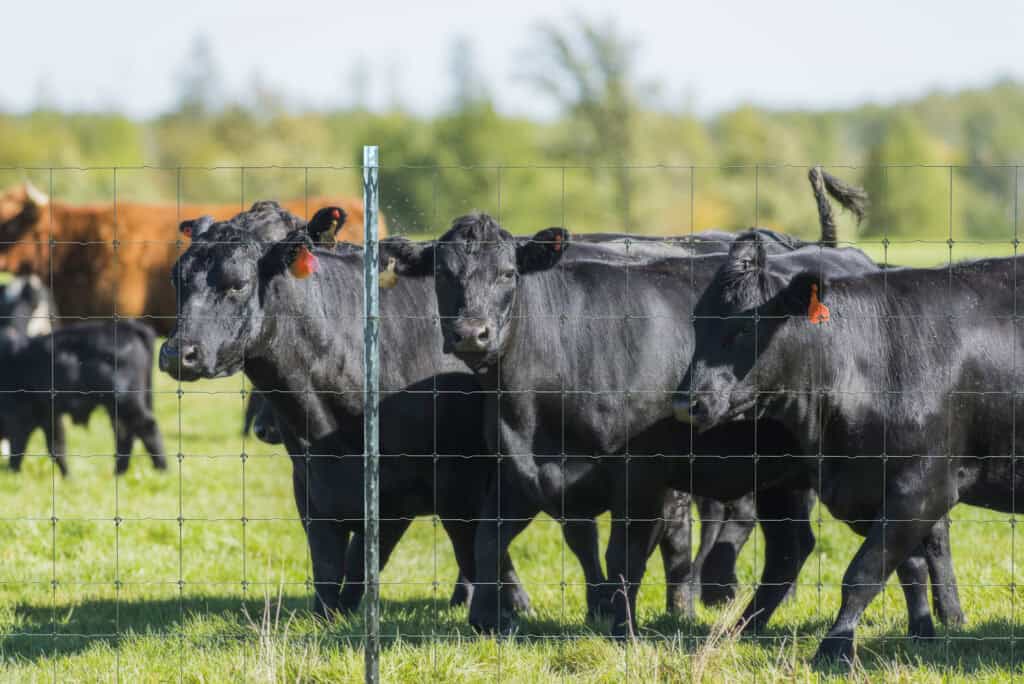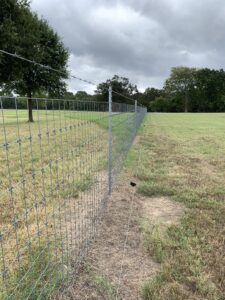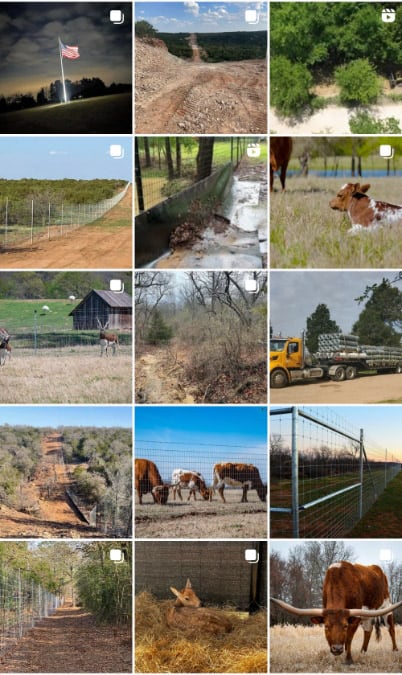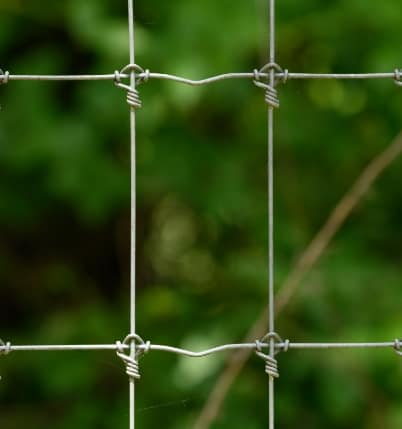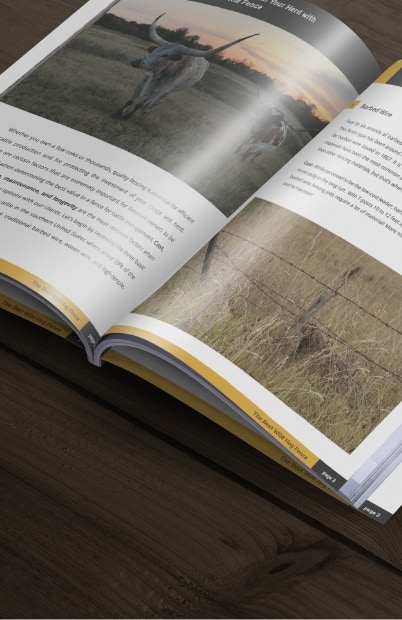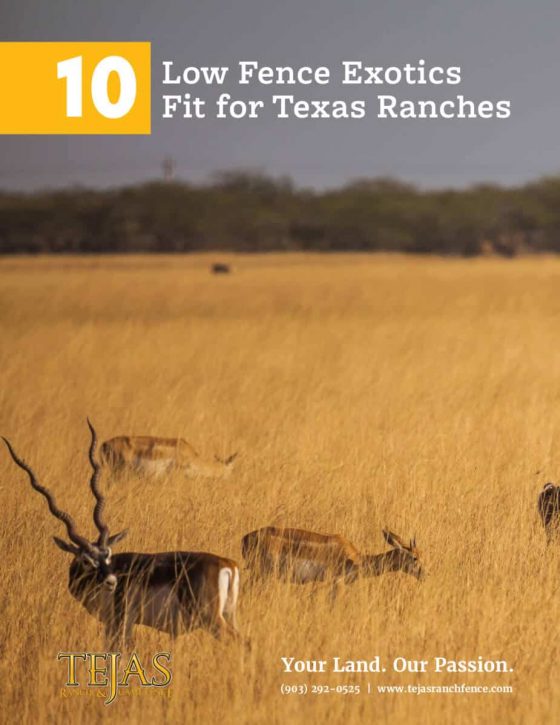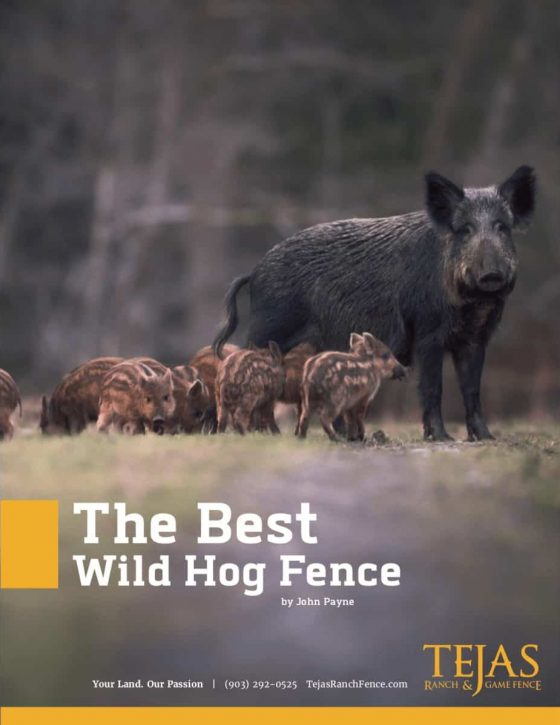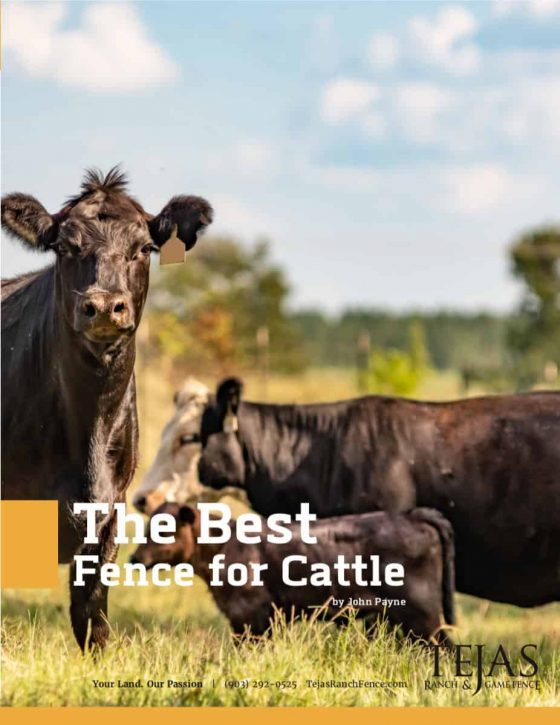When managing livestock, installing the correct type of fence is a crucial investment for farmers and ranchers. Cattle fencing ensures livestock security, prevents cattle from wandering off, and protects them from predators. The cost of cattle fences can vary significantly based on material, labor, location, and maintenance. This article will explore the factors that influence cattle fence pricing.
Land Characteristics
Each property possesses unique characteristics that influence the design and cost of cattle fencing. Terrain, topography, soil composition, surface water, and geographic location are essential in determining the most effective fencing solution. Often, the very features that make a property appealing can present challenges during fence installation, affecting efficiency, completion timelines, and cost.
For instance, rugged terrain with steep slopes and rocky soils may require specialized equipment to set fence posts properly. Surface water, while beneficial for livestock, may require the implementation of water gap fencing to maintain barrier integrity.
Accessibility also significantly impacts project costs. Properties with established internal road systems facilitate easier transport and distribution, reducing labor and time expenses—conversely, remote locations lacking such infrastructure demand additional manpower and equipment, leading to increased costs.
A property’s distinct attributes—including challenging terrains, water features, and accessibility issues—can substantially influence the complexity and cost of cattle fence installation. Addressing these factors with appropriate materials and techniques is crucial for creating durable and practical fencing solutions.
Preparation
P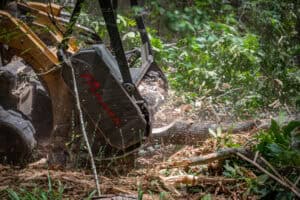 reparing the land before installing a cattle fence is crucial to the project’s overall cost. Land clearing, often necessary for new fence installations, establishes a clean and accessible path for construction. Since the bottom of the fence follows the land’s natural contour, a well-cleared route ensures a uniform final result. Although it adds to the overall expense, this process enhances the durability and effectiveness of the fence. Additionally, cleared rights-of-way (ROW) are essential access routes for transporting materials, equipment, and personnel. These cleared paths also facilitate the unrolling and stretching of high-tensile cattle fencing, providing property owners with trails for fence maintenance and monitoring.
reparing the land before installing a cattle fence is crucial to the project’s overall cost. Land clearing, often necessary for new fence installations, establishes a clean and accessible path for construction. Since the bottom of the fence follows the land’s natural contour, a well-cleared route ensures a uniform final result. Although it adds to the overall expense, this process enhances the durability and effectiveness of the fence. Additionally, cleared rights-of-way (ROW) are essential access routes for transporting materials, equipment, and personnel. These cleared paths also facilitate the unrolling and stretching of high-tensile cattle fencing, providing property owners with trails for fence maintenance and monitoring.
Another factor impacting costs is the removal of old fencing. If an existing fence needs to be dismantled, extra labor may be required, particularly in cases where fencing has become entangled with trees or dense vegetation. While this process takes additional time upfront, it ensures a clean slate for the new cattle fence. To mitigate this expense, some property owners leave the existing fence intact and install the new one alongside it. Over time, natural vegetation may fill the space between the two fences, creating a “green barrier” that enhances privacy and provides an additional visual screen for the property.
Cattle Fence Material
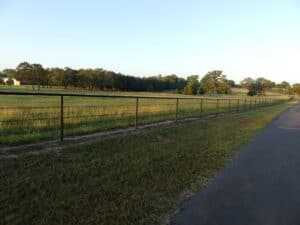 Selecting high-quality materials and an experienced contractor are the most crucial steps in ensuring the durability and effectiveness of a cattle fence. One fencing option stands out as the industry leader in performance and value: high-tensile, fixed-knot mesh with a Class 3 galvanized or zinc-aluminum coating. Pairing this with heavyweight commercial-grade galvanized t-posts, galvanized pipe, and reinforced pipe gates – including hinges, latches, and welded wire mesh – ensures a long-lasting and resilient fencing system. While galvanized components may add a slight upfront cost, their superior resistance to rust and wear makes them a far better long-term investment.
Selecting high-quality materials and an experienced contractor are the most crucial steps in ensuring the durability and effectiveness of a cattle fence. One fencing option stands out as the industry leader in performance and value: high-tensile, fixed-knot mesh with a Class 3 galvanized or zinc-aluminum coating. Pairing this with heavyweight commercial-grade galvanized t-posts, galvanized pipe, and reinforced pipe gates – including hinges, latches, and welded wire mesh – ensures a long-lasting and resilient fencing system. While galvanized components may add a slight upfront cost, their superior resistance to rust and wear makes them a far better long-term investment.
Consistency in materials is essential for maximizing longevity. If the wire mesh is zinc-coated but the posts are not, galvanic corrosion can occur, causing premature deterioration at critical connection points. Using fully galvanized components prevents this issue, ensuring a more durable and uniform fence structure. Additionally, a consistent, galvanized finish extends the fence’s lifespan and enhances its overall appearance – something every landowner appreciates.
Optional Features
Water Gaps
The number of waterways crossing a fence line is crucial in a cattle fence’s overall cost and effectiveness. A well-built fence is designed to contain livestock while keeping unwanted animals out, but what happens when a creek, river, or other waterway interrupts the fence line? The solution is a water gap fence system. When water levels are low, a properly designed water gap will close off the opening, preventing animals from wandering through the waterway. When water levels rise, the water gap fence will lift, allowing debris like branches, leaves, and other vegetation to pass through instead of piling up and damaging the wall. Trapped debris can pressure the fence structure without this feature, leading to costly repairs and potential breaches.
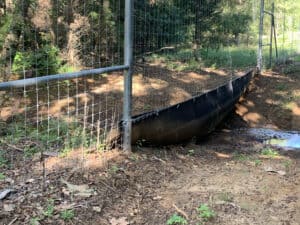
Any cattle rancher knows the hassle of checking water gaps after a storm – sometimes, it’s a quick inspection, but oftentimes, it means hours or even days of clearing blockages. Tejas has developed an innovative water gap system that functions effectively in all conditions – rain or shine. Unlike rigid metal barriers that can become clogged or damaged, Tejas’s Floatmaster water gap system uses flexible rubber mats that rise with the water, allowing logs and debris to pass underneath without compromising the fence structure. When dry, the rubber mats conform to the ground, sealing the gap. This low-maintenance solution ensures that a cattle fence remains secure over waterways, preserving the enclosure’s integrity and the herd’s safety.
Gates
Gates are essential for maintaining security while allowing easy access for people, vehicles, and equipment. Additionally, gates may be required at points where utilities, such as pipelines or overhead transmission lines, intersect the fence and must be serviced.
Cattle fence gates are typically constructed using round tubular steel frames for durability and longevity. High-quality gates utilize welded construction to enhance strength, and the infill mesh should be carefully selected to maintain the fence’s integrity and prevent cattle from pushing through or escaping. To withstand the elements and ensure long-term performance, gate finishes are often galvanized, powder-coated, or treated with a combination of both for a superior, long-lasting protective layer.
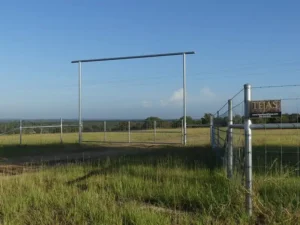
Custom entry gates and accessories, including automatic openers, solar-powered systems, keypad entry, and vehicle sensors, offer both convenience and security and add to the overall cost. Many ranch owners choose to enhance their main entrance with decorative elements that reflect the character of their property. A custom overhead gate structure featuring metal artwork, the ranch name, or other design elements creates a striking first impression and serves a functional purpose.
The number and type of cattle fence gates and any additional features will ultimately impact the total cost of a fencing project. However, selecting high-quality materials and construction methods ensures that gates remain secure, functional, and durable for years.
Cattle Guards
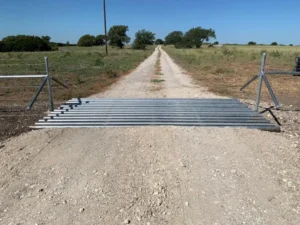 Cattle guards effectively prevent livestock from crossing designated boundaries while allowing vehicles to pass through without the need for gates. Many ranches rely on cattle guards to contain cattle within fenced areas, while others use them to deter wildlife from entering the property. When integrated into a cattle fence system, cattle guards provide an extra layer of security in case a gate is left open, malfunctions, or sustains damage from passing vehicles or equipment.
Cattle guards effectively prevent livestock from crossing designated boundaries while allowing vehicles to pass through without the need for gates. Many ranches rely on cattle guards to contain cattle within fenced areas, while others use them to deter wildlife from entering the property. When integrated into a cattle fence system, cattle guards provide an extra layer of security in case a gate is left open, malfunctions, or sustains damage from passing vehicles or equipment.
Cattle guards work by creating an unstable footing that discourages livestock from attempting to cross. The combination of rounded pipe and spacing between bars makes cattle hesitant due to depth perception issues and the risk of slipping. While most cattle instinctively avoid cattle guards, some mainly determined animals may attempt to jump or walk across. To further prevent escapes, installing a wider cattle guard – extending from the standard 8 feet to 16 feet – can significantly reduce the likelihood of successful crossings.
Well-built cattle guards, including large trucks carrying livestock, feed, or construction materials, are engineered to withstand heavy traffic. A strong structural base is essential for durability, and I-beam construction is preferred due to its strength and ease of fabrication. The top layer is typically made from 2 7/8″ galvanized steel pipe welded to the frame to create a sturdy, long-lasting surface.
The number and size of cattle guards required will influence the overall cost of a cattle fencing project. However, investing in high-quality materials and proper installation ensures long-term effectiveness in keeping livestock securely contained while maintaining ease of access for vehicles.
Predator Wire
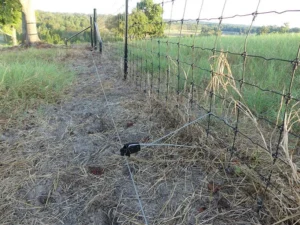
Ranchers can install additional deterrents, such as a predator apron or electric wires, to enhance the security of a cattle fence and protect livestock from potential attacks. A predator apron, which consists of fencing material buried along the base of the wall and extended outward, prevents predators from digging underneath and gaining access to the pasture. Another effective solution is adding one or more electric wires along the top or bottom of the fence to discourage predators from attempting to climb over or burrow under the wall. These deterrents provide an extra layer of protection, helping safeguard cattle and reduce predation risk.
Sight Block
Another optional feature that can enhance a cattle fence is the addition of a synthetic mesh material that serves as both a windscreen and a sight block. This material, typically with an 85% screening value, helps obscure sightlines outside the property, increasing privacy and preventing passersby from seeing valuable livestock. The sight-blocking mesh can also help ranchers manage their cattle’s environment by shielding them from harsh winds and icy northern gusts that can cause stress to the herd. It can also block undesirable views outside the fence, such as neighboring properties or roadways. Remember that since the mesh material increases wind resistance, it is essential to reinforce the fence structure by using additional tubular steel posts instead of standard t-posts. This added support ensures the fence remains strong and durable, even in high-wind conditions.
Cattle Fence Pricing
Quantities and Economies of Scale
As with many large-scale projects, economies of scale are essential in cattle fence installation. Cost efficiencies typically begin at around two miles of fencing, but more significant projects help reduce fixed costs, improve installation efficiency, and allow crews to install more fencing daily.
So, how much does a quality cattle fence cost?
Typical Cattle Fence Cost per Mile
Many people unfamiliar with high-tensile, fixed-knot cattle fences expect it to cost significantly more than traditional fence options. High-tensile, fixed-knot
Class 3 fencing is a superior option, offering significant savings over time compared to conventional Class 1 barbed wire or hinged-joint field fencing. While the initial installation cost is similar to barbed wire, fixed-knot fencing allows for 20-foot post spacing, reducing the need for intermediate posts, stays, or stiffeners. Additionally, it comes in long rolls of 330 or 660 feet, making installation more efficient by eliminating the need to string individual wires. Once installed, this fencing requires little maintenance, saving time and money. With a lifespan two to three times longer than low-carbon barbed wire or hinged-joint fencing, high-tensile, fixed-knot fencing is the clear choice for durability and cost-effectiveness.
Your property is unique, and there is no one-size-fits-all solution. Many independent variables influence the final price. Assuming 2+ miles of cattle fence, a base cost is approximately $3-$4 per linear foot, or $20,000 per mile. With an average set of variables like gates, water gaps, and land preparation included, that cost rises to $25,000-$30,000 / mile (as of December 2024).
|
Cattle Fence Cost |
|
|
$20,000 |
Cattle Fence – $ / Mile |
|
$3.50 |
Cattle Fence – $ / Linear Foot – without water gaps, gates, or any extras |
|
$7.15 |
Floatmaster Water Gap – $ / Square Foot |
|
$1.20 |
Predator Wire – $ / Linear Foot |
| $11.35 |
Sight Block – $ / Linear Foot |
Every property has distinct characteristics, and elements like terrain, soil composition, and local labor costs can greatly impact the cattle fencing expense. To get the most precise estimate, it’s best to request a customized quote that considers these specific factors.
Request Estimate
To accurately estimate a cost for your property, request an estimate through our website or call/text (903) 292-0525. The experienced estimators at Tejas Ranch & Game Fence, utilizing sophisticated mapping software and specially designed cattle fence installation calculators, can give you an estimate on a particular property.
